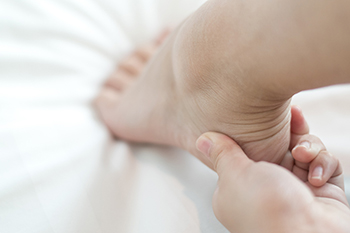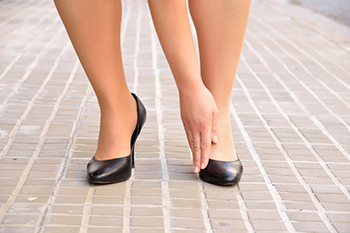Connect With Us
Blog
Items filtered by date: April 2023
Who Can Develop Sever’s Disease?

Sever’s disease is a condition that affects the heel of the foot. Children and young teenagers who are physically active may be prone to developing this ailment, which may cause the child to limp or walk on their tiptoes. It is defined as an inflammation of the muscles and tendons surrounding the growth plate in the heel, and it happens when this plate grows faster than the heel bone. This age group of children from 5 to 11 who frequently participate in running and jumping activities can develop this painful condition, which can be accompanied by swelling. Additional reasons why Sever's disease may happen can be from wearing shoes that do not fit correctly, being overweight, or if one leg is shorter than the other. Treatment often begins with temporarily stopping the activity that caused the pain and elevating the affected foot as often as possible. Wearing custom-made orthotics may help the child to feel better, which can provide the necessary support as the healing process occurs. If your child has symptoms of Sever’s disease, it is suggested that you confer with a podiatrist who can effectively determine the cause of their heel pain, and treat it accordingly.
Sever's disease often occurs in children and teens. If your child is experiencing foot or ankle pain, see Bill Brown, DPM from Brown Podiatry. Our doctor can treat your child’s foot and ankle needs.
Sever’s Disease
Sever’s disease is also known as calcaneal apophysitis, which is a medical condition that causes heel pain I none or both feet. The disease is known to affect children between the ages of 8 and 14.
Sever’s disease occurs when part of the child’s heel known as the growth plate (calcaneal epiphysis) is attached to the Achilles tendon. This area can suffer injury when the muscles and tendons of the growing foot do not keep pace with bone growth. Therefore, the constant pain which one experiences at the back of the heel will make the child unable to put any weight on the heel. The child is then forced to walk on their toes.
Symptoms
Acute pain – Pain associated with Sever’s disease is usually felt in the heel when the child engages in physical activity such as walking, jumping and or running.
Highly active – Children who are very active are among the most susceptible in experiencing Sever’s disease, because of the stress and tension placed on their feet.
If you have any questions, please feel free to contact our office located in Scranton, PA . We offer the newest diagnostic and treatment technologies for all your foot and ankle injuries.
Ways to Combat Chronic Foot Pain

Foot pain is common and if not controlled, can become chronic and interfere with one’s quality of life. Because foot pain has many potential causes, diagnostic tests like X-rays or MRIs are often necessary to pinpoint what is going on. Common reasons for foot pain may include arthritis, Morton’s neuroma, and plantar fasciitis. Arthritis will present itself with joint pain, swelling, and sometimes deformity. It often shows itself in the big toe or ankle. Morton’s neuroma involves the swelling of a nerve, and one might feel pain in the midsole of the foot that can radiate between the toes. Plantar fasciitis is when the plantar fascia, the band of connective tissue running from the heel of the foot to the toes, becomes inflamed or sustains micro-tears and causes pain in the heel and arch of the foot. If you have pain in your feet and you do not find relief with cessation from the activity that caused it, or if the pain gets worse, it is suggested that you seek the counsel of a podiatrist. A podiatrist can perform radiologic tests to diagnose the problem and provide treatment options.
Foot Pain
Foot pain can be extremely painful and debilitating. If you have a foot pain, consult with Bill Brown, DPM from Brown Podiatry. Our doctor will assess your condition and provide you with quality foot and ankle treatment.
Causes
Foot pain is a very broad condition that could be caused by one or more ailments. The most common include:
- Bunions
- Hammertoes
- Plantar Fasciitis
- Bone Spurs
- Corns
- Tarsal Tunnel Syndrome
- Ingrown Toenails
- Arthritis (such as Gout, Rheumatoid, and Osteoarthritis)
- Flat Feet
- Injury (from stress fractures, broken toe, foot, ankle, Achilles tendon ruptures, and sprains)
- And more
Diagnosis
To figure out the cause of foot pain, podiatrists utilize several different methods. This can range from simple visual inspections and sensation tests to X-rays and MRI scans. Prior medical history, family medical history, and any recent physical traumatic events will all be taken into consideration for a proper diagnosis.
Treatment
Treatment depends upon the cause of the foot pain. Whether it is resting, staying off the foot, or having surgery; podiatrists have a number of treatment options available for foot pain.
If you have any questions, please feel free to contact our office located in Scranton, PA . We offer the newest diagnostic and treatment technologies for all your foot care needs.
Ledderhose Disease

Ledderhose disease, also known as plantar fibromatosis, is rare and impacts the bottom of the feet. This disease presents as a buildup of connective tissue in the feet, which forms into lumps or nodules on the fascia located on the sole of the foot. The fascia is a connective tissue that runs from the heel bone to the toes, and when it thickens, it can form nodules, which may be painless at first and, over time, may cause discomfort and pain. The skin may tighten, there might be itching and stinging in the surrounding area, and pain in the foot and ankle joints can develop. The cause of this ailment is not known. However, some believe that it is caused by genetics or environmental factors. Risk factors include regular alcohol consumption, liver disease, and diabetes. It most often strikes those in middle or older age and is more common in men than women. Treatment of Ledderhose disease depends on its severity. It is suggested that if you develop such nodules in your feet, you contact a podiatrist for an examination, diagnosis and healing options that are right for you.
Some foot conditions may require additional professional care. If you have any concerns, contact Bill Brown, DPM of Brown Podiatry. Our doctor can provide the care you need to keep you pain-free and on your feet.
Rare Foot Conditions
The majority of foot conditions are common and can be treated by a podiatrist. Standard diagnostic procedures are generally used to identify specific conditions and treatment can be rendered. A podiatrist also treats rare foot conditions which can be difficult to diagnose and may need extra attention and care.
There are many rare foot conditions that can affect children. Some of these can include:
- Freiberg’s disease
- Kohler’s disease
- Maffucci syndrome
Freiberg’s disease - This can be seen as a deterioration and flattening of a metatarsal bone that exists in the ball of the foot. It typically affects pre-teen and teenage girls, but can affect anyone at any age. Symptoms that can accompany this can be swelling, stiffness, and the patient may limp.
Kohler’s disease - This often targets the bone in the arch of the foot and affects younger boys. It can lead to an interruption of the blood supply which ultimately can lead to bone deterioration. The patient may limp or experience tenderness, swelling, and redness.
Maffucci syndrome - This affects the long bones in a child’s foot leading to the development of abnormal bone lesions. They are benign growths and typically develop in early childhood and the bones may be susceptible to breaking.
A podiatrist can properly diagnose and treat all types of rare foot conditions. If your child is affected by any of these symptoms or conditions, please don’t hesitate to call our office so the correct treatment method can begin.
If you have any questions please feel free to contact our office located in Scranton, PA . We offer the newest diagnostic tools and technology to treat your foot and ankle needs.
Wounds That Don't Heal Need to Be Checked
Is Wearing High Heels Bad for the Feet?

Wearing high heels can make you feel more attractive, but there is often a price to pay for this fashion. High heels can cause a host of foot problems that result in pain. Wearing them too often or for too long can cause other foot problems, such as hammertoes, bunions, or neuromas. Additionally, wearing high heels can put stress on the back, hips, and legs which can affect posture, gait, and balance. High heels place feet in an extended downward position and increase pressure on the forefoot. The rest of the body is thrown off and must compensate for the change in balance. Wearing high heels interferes with the ability to push off the ground with the toes efficiently. The rest of the body must work harder to propel the body forward. The higher the heel, the worse things can get. Trying to walk on uneven surfaces or with elevations and declines can be hazardous and increase the risk of injury. It is best for your health to wear lower-heeled shoes. Occasional high heel use is acceptable with frequent time off the feet and stretching and relaxing the feet while wearing. See a podiatrist to learn more about wearing high heels and getting help for the problems high heels may create is suggested.
High heels have a history of causing foot and ankle problems. If you have any concerns about your feet or ankles, contact Bill Brown, DPM from Brown Podiatry. Our doctor can provide the care you need to keep you pain-free and on your feet.
Effects of High Heels on the Feet
High heels are popular shoes among women because of their many styles and societal appeal. Despite this, high heels can still cause many health problems if worn too frequently.
Which Parts of My Body Will Be Affected by High Heels?
- Ankle Joints
- Achilles Tendon – May shorten and stiffen with prolonged wear
- Balls of the Feet
- Knees – Heels cause the knees to bend constantly, creating stress on them
- Back – They decrease the spine’s ability to absorb shock, which may lead to back pain. The vertebrae of the lower back may compress.
What Kinds of Foot Problems Can Develop from Wearing High Heels?
- Corns
- Calluses
- Hammertoe
- Bunions
- Morton’s Neuroma
- Plantar Fasciitis
How Can I Still Wear High Heels and Maintain Foot Health?
If you want to wear high heeled shoes, make sure that you are not wearing them every day, as this will help prevent long term physical problems. Try wearing thicker heels as opposed to stilettos to distribute weight more evenly across the feet. Always make sure you are wearing the proper shoes for the right occasion, such as sneakers for exercising. If you walk to work, try carrying your heels with you and changing into them once you arrive at work. Adding inserts to your heels can help cushion your feet and absorb shock. Full foot inserts or metatarsal pads are available.
If you have any questions please feel free to contact our office located in Scranton, PA . We offer the newest diagnostic and treatment technologies for all your foot and ankle needs.

